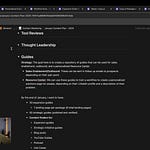How Top of the Funnel Content Strategy Worked Before AI
Top of the funnel content has traditionally been informational, educational, and targeted at people new to a topic. The goal was to teach audiences basic concepts at an entry level to get them started on a path.
But creating this content was challenging before AI. Because the search volume for these topics was so high and competitive, it became very expensive to produce the content needed to rank. It was also difficult to hire enough quality writers to cover the breadth of topics required.
This pushed companies into something known as the "Iron Triangle" of speed, cost, and quality—and could only optimize for two at the expense of the third. For example:
High quality and speed required high costs.
Low costs and high speed resulted in lower quality.
High quality and low costs took more time.
The Iron Triangle is something that affects the majority of projects (not just Content Marketing), and it’s one of the reasons why using AI for content feels like cheating. More on that in a bit.
First, let’s look at the problems of the traditional TOFU content strategy in more depth.
The Problems with Top of the Funnel Content Strategy Before AI
Before AI, the main issues for companies creating high-quality TOFU content were:
High costs to produce content at the scale and quality needed to be competitive
Difficulty staffing enough skilled writers to cover the topic breadth
Tradeoffs between speed, cost, and quality—again, optimizing for two meant sacrificing the third
Time-consuming, manual processes for keyword research, content briefs, writing, and editing
Challenges maintaining consistent brand voice and content structure across many writers
This made it very hard for all but the largest companies to execute an effective top-of-the-funnel content strategy (which is ironic, because content marketing started as the best option for smaller, bootstrapped companies who couldn’t afford to compete on paid ad platforms).
In other words, David beat Goliath with content marketing in 2010. Then a bunch of giants saw that, made bigger sling shots, and started beating the s*** out of David around 2020 and onward.
^^A huge generalization, especially on the dates, but you get the idea.
How TOFU Content Strategy Works Now with AI
AI-powered tools and workflows now allow companies to break through the "Iron Triangle" and produce high-quality top-of-the-funnel content at scale, speed, and affordable costs.
I now automate repeatable parts of the keyword research, content brief creation, and the writing process, while still keeping a "human-in-the-loop" for quality review and brand voice. This means we can publish at a much higher cadence than before, giving us a ton of benefits that extend beyond SEO.
Benefits of Creating TOFU Content with AI
Efficiency and Scale:
AI provided faster generation of first drafts by automating tasks like content structuring, internal link building, research, and generating articles.
Teams can produce a higher volume of content in less time, allowing for broader coverage of keywords and topics.
Cost Savings:
AI reduces reliance on large teams of writers and editors, significantly lowering production costs and turnaround times.
Complex strategies, like creating pillar pages and subtopics (hub-and-spoke models), become affordable for smaller organizations.
Consistency and Quality:
AI tools establish content accuracy by integrating internal and external research, maintaining brand voice, and improving style consistency.
A human-in-the-loop review process ensures the content meets quality standards for accuracy always. Then a second human reviews content for refreshes.
Enhanced Strategic Insights:
AI provides analytics on what content performs well, enabling data-driven refinements and focus on successful strategies.
Content creation aligns with emerging trends and customer needs, which can be quickly adapted as insights evolve.
Multi-Purpose Utility:
The generated content serves multiple purposes, including SEO, sales enablement, social media engagement, and knowledge repositories.
Essentially, AI makes it easier to experiment, iterate, and discover winning TOFU content strategies without heavy upfront investment.
How to Do Top of the Funnel Content Strategy Now, Step-by-Step
Here's the process our team uses:
Do keyword research to identify target topics and head terms, using traditional SEO tools (we use Ahrefs)
Build AI workflows rather than copilots to create your first draft. I won’t like, this is a bit of a process, and can take 2-4 hours to get right. But once it’s right, you’ll save 6-8 hours on every article generation.
Have a human editor review for quality, accuracy, and helpfulness
Publish the content and promote through relevant channels
Track performance and identify areas for improvement
Update and optimize the content as needed over time with human editors
With AI to assist with the manual, time-consuming aspects (while still maintaining human oversight), companies can now produce top-of-funnel content at higher velocities and lower costs than ever before.
This opens up strategies that simply weren't possible before.
The key is building the right workflows, tools, and processes to maintain quality while increasing speed and efficiency. When done right, AI allows companies to compete at the top of the funnel without breaking the bank or sacrificing quality.
TOFU Content Still Matters
Businesses can now break free from the constraints of the "Iron Triangle" by leveraging AI-powered tools and workflows. They can create high-quality, scalable content at unprecedented speeds and affordable costs.
But remember: AI is not a replacement for human expertise and oversight.
The most successful content strategies will strike the right balance between automation and human touch, ensuring that every piece of content is accurate, helpful, and aligned with the brand's voice and values.
Fun Note: If you’re wondering how much of this article was written by AI based on the transcript from the video above, I’d argue it’s about 80-85%. I have a workflow to write the first draft, and second to double-review it to the standards I like, which gives me a second draft to edit.
More importantly, here’s what you should know: I started recording the video at 6:00 pm my time, and will release this post + the video + the LinkedIn post by 6:40 pm my time. That’s 3 pieces of content across 3 channels (Substack, LinkedIn, and email), in 40 minutes.
Just wild, wild times we’re livin’ in.












Share this post